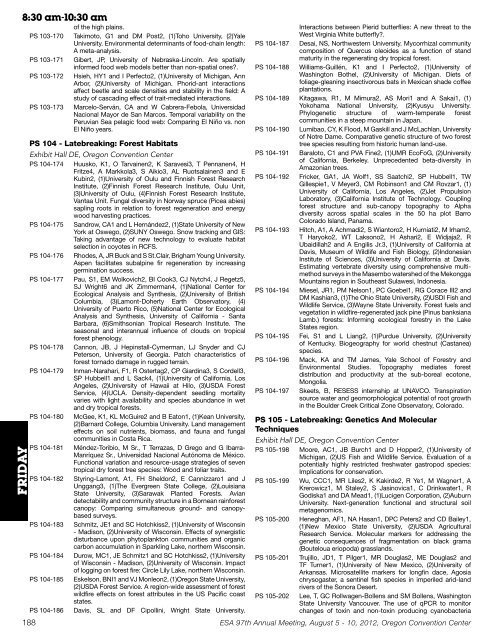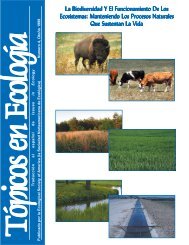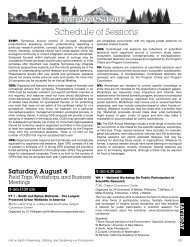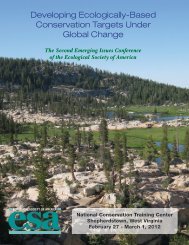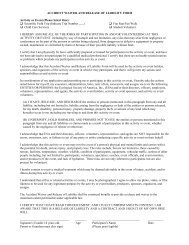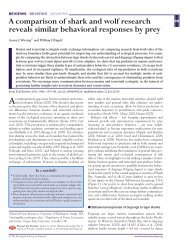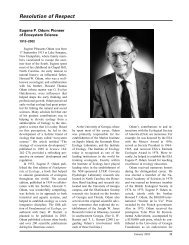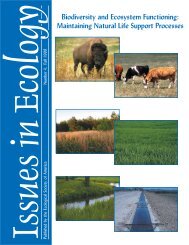Printed Program (PDF) - Ecological Society of America
Printed Program (PDF) - Ecological Society of America
Printed Program (PDF) - Ecological Society of America
You also want an ePaper? Increase the reach of your titles
YUMPU automatically turns print PDFs into web optimized ePapers that Google loves.
FRIDAY<br />
8:30 am-10:30 am<br />
<strong>of</strong> the high plains.<br />
PS 103-170 Takimoto, G1 and DM Post2, (1)Toho University, (2)Yale<br />
University. Environmental determinants <strong>of</strong> food-chain length:<br />
A meta-analysis.<br />
PS 103-171 Gibert, JP, University <strong>of</strong> Nebraska-Lincoln. Are spatially<br />
informed food web models better than non-spatial ones?.<br />
PS 103-172 Hsieh, HY1 and I Perfecto2, (1)University <strong>of</strong> Michigan, Ann<br />
Arbor, (2)University <strong>of</strong> Michigan. Phorid-ant interactions<br />
affect beetle and scale densities and stability in the field: A<br />
study <strong>of</strong> cascading effect <strong>of</strong> trait-mediated interactions.<br />
PS 103-173 Marcelo-Serván, CA and W Cabrera-Febola, Universidad<br />
Nacional Mayor de San Marcos. Temporal variability on the<br />
Peruvian Sea pelagic food web: Comparing El Niño vs. non<br />
El Niño years.<br />
PS 104 - Latebreaking: Forest Habitats<br />
Exhibit Hall DE, Oregon Convention Center<br />
PS 104-174 Huusko, K1, O Tarvainen2, K Saravesi3, T Pennanen4, H<br />
Fritze4, A Markkola3, S Aikio3, AL Ruotsalainen3 and E<br />
Kubin2, (1)University <strong>of</strong> Oulu and Finnish Forest Research<br />
Institute, (2)Finnish Forest Research Institute, Oulu Unit,<br />
(3)University <strong>of</strong> Oulu, (4)Finnish Forest Research Institute,<br />
Vantaa Unit. Fungal diversity in Norway spruce (Picea abies)<br />
sapling roots in relation to forest regeneration and energy<br />
wood harvesting practices.<br />
PS 104-175 Sandrow, CA1 and L Hernández2, (1)State University <strong>of</strong> New<br />
York at Oswego, (2)SUNY Oswego. Snow tracking and GIS:<br />
Taking advantage <strong>of</strong> new technology to evaluate habitat<br />
selection in coyotes in RCFS.<br />
PS 104-176 Rhodes, A, JR Buck and S St.Clair, Brigham Young University.<br />
Aspen facilitates subalpine fir regeneration by increasing<br />
germination success.<br />
PS 104-177 Pau, S1, EM Wolkovich2, BI Cook3, CJ Nytch4, J Regetz5,<br />
SJ Wright6 and JK Zimmerman4, (1)National Center for<br />
<strong>Ecological</strong> Analysis and Synthesis, (2)University <strong>of</strong> British<br />
Columbia, (3)Lamont-Doherty Earth Observatory, (4)<br />
PS 104-178<br />
University <strong>of</strong> Puerto Rico, (5)National Center for <strong>Ecological</strong><br />
Analysis and Synthesis, University <strong>of</strong> California - Santa<br />
Barbara, (6)Smithsonian Tropical Research Institute. The<br />
seasonal and interannual influence <strong>of</strong> clouds on tropical<br />
forest phenology.<br />
Cannon, JB, J Hepinstall-Cymerman, LJ Snyder and CJ<br />
Peterson, University <strong>of</strong> Georgia. Patch characteristics <strong>of</strong><br />
forest tornado damage in rugged terrain.<br />
PS 104-179 Inman-Narahari, F1, R Ostertag2, CP Giardina3, S Cordell3,<br />
SP Hubbell1 and L Sack4, (1)University <strong>of</strong> California, Los<br />
Angeles, (2)University <strong>of</strong> Hawaii at Hilo, (3)USDA Forest<br />
Service, (4)UCLA. Density-dependent seedling mortality<br />
varies with light availability and species abundance in wet<br />
and dry tropical forests.<br />
PS 104-180 McGee, K1, KL McGuire2 and B Eaton1, (1)Kean University,<br />
(2)Barnard College, Columbia University. Land management<br />
effects on soil nutrients, biomass, and fauna and fungal<br />
communities in Costa Rica.<br />
PS 104-181 Méndez-Toribio, M Sr., T Terrazas, D Grego and G Ibarra-<br />
Manríquez Sr., Universidad Nacional Autónoma de México.<br />
Functional variation and resource-usage strategies <strong>of</strong> seven<br />
tropical dry forest tree species: Wood and foliar traits.<br />
PS 104-182 Styring-Lamont, A1, FH Sheldon2, E Cannizzaro1 and J<br />
Unggang3, (1)The Evergreen State College, (2)Louisiana<br />
State University, (3)Sarawak Planted Forests. Avian<br />
PS 104-183<br />
detectability and community structure in a Bornean rainforest<br />
canopy: Comparing simultaneous ground- and canopybased<br />
surveys.<br />
Schmitz, JE1 and SC Hotchkiss2, (1)University <strong>of</strong> Wisconsin<br />
- Madison, (2)University <strong>of</strong> Wisconsin. Effects <strong>of</strong> synergistic<br />
disturbance upon phytoplankton communities and organic<br />
carbon accumulation in Sparkling Lake, northern Wisconsin.<br />
PS 104-184 Durow, MC1, JE Schmitz1 and SC Hotchkiss2, (1)University<br />
<strong>of</strong> Wisconsin - Madison, (2)University <strong>of</strong> Wisconsin. Impact<br />
<strong>of</strong> logging on forest fire: Circle Lily Lake, northern Wisconsin.<br />
PS 104-185 Eskelson, BNI1 and VJ Monleon2, (1)Oregon State University,<br />
(2)USDA Forest Service. A region-wide assessment <strong>of</strong> forest<br />
wildfire effects on forest attributes in the US Pacific coast<br />
states.<br />
PS 104-186 Davis, SL and DF Cipollini, Wright State University.<br />
Interactions between Pierid butterflies: A new threat to the<br />
West Virginia White butterfly?.<br />
PS 104-187 Desai, NS, Northwestern University. Mycorrhizal community<br />
composition <strong>of</strong> Quercus oleoides as a function <strong>of</strong> stand<br />
maturity in the regenerating dry tropical forest.<br />
PS 104-188 Williams-Guillén, K1 and I Perfecto2, (1)University <strong>of</strong><br />
Washington Bothel, (2)University <strong>of</strong> Michigan. Diets <strong>of</strong><br />
foliage-gleaning insectivorous bats in Mexican shade c<strong>of</strong>fee<br />
plantations.<br />
PS 104-189 Kitagawa, R1, M Mimura2, AS Mori1 and A Sakai1, (1)<br />
Yokohama National University, (2)Kyusyu University.<br />
Phylogenetic structure <strong>of</strong> warm-temperate forest<br />
communities in a steep mountain in Japan.<br />
PS 104-190 Lumibao, CY, K Flood, M Gaskill and J McLachlan, University<br />
<strong>of</strong> Notre Dame. Comparative genetic structure <strong>of</strong> two forest<br />
tree species resulting from historic human land-use.<br />
PS 104-191 Baraloto, C1 and PVA Fine2, (1)UMR EcoFoG, (2)University<br />
<strong>of</strong> California, Berkeley. Unprecedented beta-diversity in<br />
Amazonian trees.<br />
PS 104-192 Fricker, GA1, JA Wolf1, SS Saatchi2, SP Hubbell1, TW<br />
Gillespie1, V Meyer3, CM Robinson1 and CM Rovzar1, (1)<br />
University <strong>of</strong> California, Los Angeles, (2)Jet Propulsion<br />
Laboratory, (3)California Institute <strong>of</strong> Technology. Coupling<br />
forest structure and sub-canopy topography to Alpha<br />
diversity across spatial scales in the 50 ha plot Barro<br />
Colorado Island, Panama.<br />
PS 104-193 Hitch, A1, A Achmadi2, S Wiantoro2, H Kurniati2, M Irham2,<br />
T Haryoko2, WT Laksono2, H Ashari2, E Widjaja2, R<br />
Ubaidillah2 and A Engilis Jr.3, (1)University <strong>of</strong> California at<br />
Davis, Museum <strong>of</strong> Wildlife and Fish Biology, (2)Indonesian<br />
Institute <strong>of</strong> Sciences, (3)University <strong>of</strong> California at Davis.<br />
Estimating vertebrate diversity using comprehensive multimethod<br />
surveys in the Masembo watershed <strong>of</strong> the Mekongga<br />
Mountains region in Southeast Sulawesi, Indonesia.<br />
PS 104-194 Miesel, JR1, PM Nelson1, PC Goebel1, RG Corace III2 and<br />
DM Kashian3, (1)The Ohio State University, (2)USDI Fish and<br />
Wildlife Service, (3)Wayne State University. Forest fuels and<br />
vegetation in wildfire-regenerated jack pine (Pinus banksiana<br />
Lamb.) forests: Informing ecological forestry in the Lake<br />
States region.<br />
PS 104-195 Fei, S1 and L Liang2, (1)Purdue University, (2)University<br />
<strong>of</strong> Kentucky. Biogeography for world chestnut (Castanea)<br />
species.<br />
PS 104-196 Mack, KA and TM James, Yale School <strong>of</strong> Forestry and<br />
Environmental Studies. Topography mediates forest<br />
distribution and productivity at the sub-boreal ecotone,<br />
Mongolia.<br />
PS 104-197 Skeets, B, RESESS internship at UNAVCO. Transpiration<br />
source water and geomorphological potential <strong>of</strong> root growth<br />
in the Boulder Creek Critical Zone Observatory, Colorado.<br />
PS 105 - Latebreaking: Genetics And Molecular<br />
Techniques<br />
Exhibit Hall DE, Oregon Convention Center<br />
PS 105-198 Moore, AC1, JB Burch1 and D Hopper2, (1)University <strong>of</strong><br />
Michigan, (2)US Fish and Wildlife Service. Evaluation <strong>of</strong> a<br />
potentially highly restricted freshwater gastropod species:<br />
Implications for conservation.<br />
PS 105-199 Wu, CCC1, MR Liles2, K Kakirde2, R Ye1, M Wagner1, A<br />
Krerowicz1, M Staley2, S Jasinovica1, C Drinkwater1, R<br />
Godiska1 and DA Mead1, (1)Lucigen Corporation, (2)Auburn<br />
University. Next-generation functional and structural soil<br />
metagenomics.<br />
PS 105-200 Heneghan, AF1, NA Hasan1, DPC Peters2 and CD Bailey1,<br />
(1)New Mexico State University, (2)USDA Agricultural<br />
Research Service. Molecular markers for addressing the<br />
genetic consequences <strong>of</strong> fragmentation on black grama<br />
(Bouteloua eriopoda) grasslands.<br />
PS 105-201 Trujillo, JD1, T Pilger1, MR Douglas2, ME Douglas2 and<br />
TF Turner1, (1)University <strong>of</strong> New Mexico, (2)University <strong>of</strong><br />
Arkansas. Microsatellite markers for longfin dace, Agosia<br />
chrysogaster, a sentinel fish species in imperiled arid-land<br />
rivers <strong>of</strong> the Sonora Desert.<br />
PS 105-202 Lee, T, GC Rollwagen-Bollens and SM Bollens, Washington<br />
State University Vancouver. The use <strong>of</strong> qPCR to monitor<br />
changes <strong>of</strong> toxin and non-toxin producing cyanobacteria<br />
188 ESA 97th Annual Meeting, August 5 - 10, 2012, Oregon Convention Center


